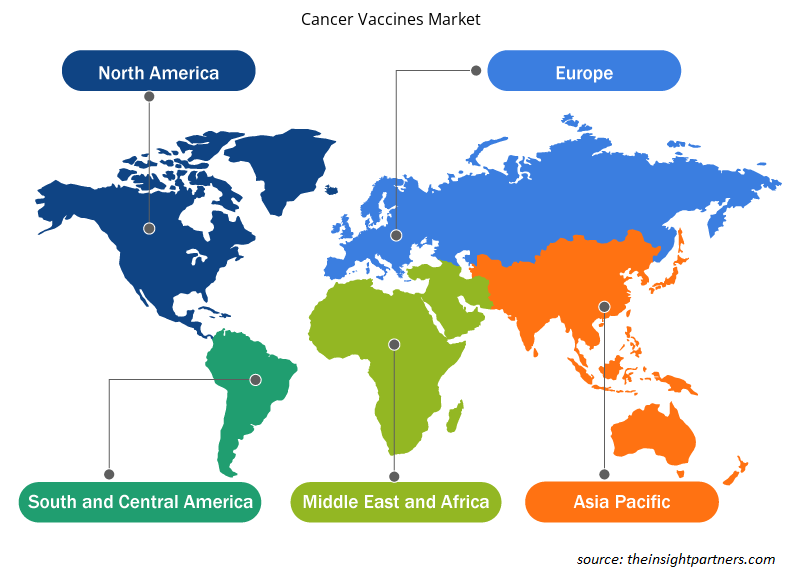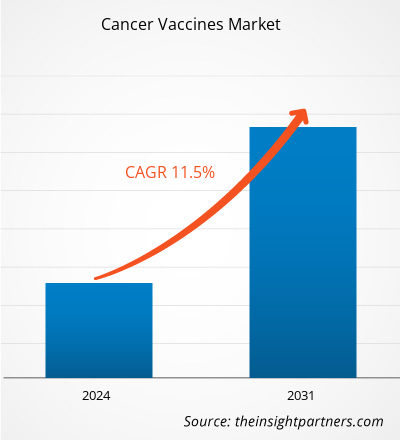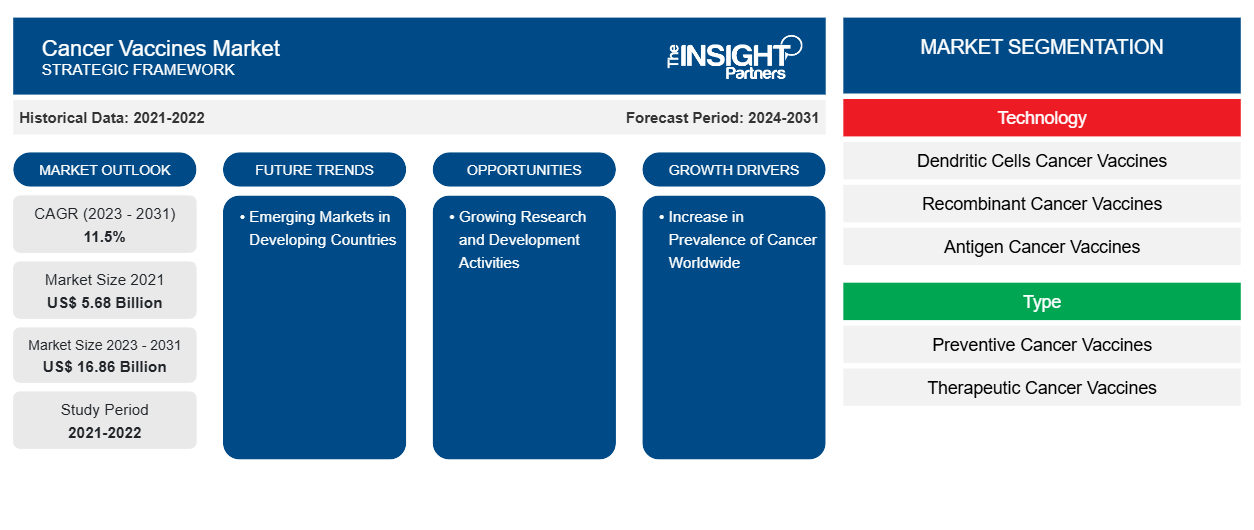Der Markt für Krebsimpfstoffe wurde auf 5,68 Mrd. USD im Jahr 2021 und xx Mrd. USD im Jahr 2023 geschätzt. Es wird erwartet, dass er bis 2031 16,86 Mrd. USD erreicht und bis 2031 eine durchschnittliche jährliche Wachstumsrate von 11,5 % verzeichnet. Die Entwicklung personalisierter Krebsimpfstoffe, die Konzentration auf Kombinationstherapien und wachsende Investitionen in die Forschung und Entwicklung von Krebsimpfstoffen werden voraussichtlich auch weiterhin die wichtigsten Trends auf dem Markt für Krebsimpfstoffe bleiben.
Marktanalyse für Krebsimpfstoffe
Die weltweit steigende Zahl an Krebserkrankungen dürfte das Wachstum des Marktes für Krebsimpfstoffe vorantreiben. Krebs ist eine der häufigsten Todesursachen weltweit und beeinträchtigt die Lebensqualität erheblich. Daher wäre Krebs eine Belastung für die Gesellschaft, wenn er nicht rechtzeitig diagnostiziert und behandelt würde. Laut Bericht der Weltgesundheitsorganisation gab es im Jahr 2022 rund 19.976.499 Krebsfälle; bis 2045 dürfte die Zahl der Krebsfälle schätzungsweise 32,6 Millionen erreichen.
Die zunehmende Verbreitung von Krebs in verschiedenen Regionen der Welt führt zu einer steigenden globalen Nachfrage nach Impfstoffen dagegen.
Marktübersicht für Krebsimpfstoffe
Der globale Markt für Krebsimpfstoffe ist nach Regionen unterteilt in Nordamerika, Europa, Asien-Pazifik, Naher Osten und Afrika sowie Süd- und Mittelamerika. Das Marktwachstum in dieser Region wird aufgrund von Faktoren wie der Zunahme der weltweiten Krebsprävalenz sowie von Initiativen globaler Gesundheitsforschungsorganisationen und wichtiger Akteure für Krebsimpfstoffe erwartet. Eine geringere Anzahl kommerziell erhältlicher Impfstoffe zur Krebsbehandlung und die hohen Impfstoffkosten werden das Marktwachstum in den Prognosejahren jedoch voraussichtlich bis zu einem gewissen Grad behindern.
Passen Sie diesen Bericht Ihren Anforderungen an
Sie erhalten kostenlos individuelle Anpassungen an jedem Bericht, einschließlich Teilen dieses Berichts oder einer Analyse auf Länderebene, eines Excel-Datenpakets sowie tolle Angebote und Rabatte für Start-ups und Universitäten.
-
Holen Sie sich die wichtigsten Markttrends aus diesem Bericht.Dieses KOSTENLOSE Beispiel umfasst eine Datenanalyse von Markttrends bis hin zu Schätzungen und Prognosen.
Treiber und Chancen auf dem Krebsimpfstoffmarkt
Initiativen globaler Gesundheitsforschungsorganisationen und wichtiger Akteure im Bereich Krebsimpfstoffe zur Förderung des Marktes.
Der Markt für Impfstoffe wird durch häufige Regierungsinitiativen und -einführungen vorangetrieben. Im Februar 2024 startete die indische Regierung eine neue Initiative, bei der Mädchen im Alter von 9 bis 14 Jahren in das allgemeine HPV-Immunisierungsprogramm (UIP) für Mädchen im Alter von 9 bis 14 Jahren aufgenommen werden. Dies ist ein wichtiger Schritt, um eine breitere Verfügbarkeit und Erschwinglichkeit des Impfstoffs zu gewährleisten.
Schwellenmärkte – eine Chance auf dem Markt für Krebsimpfstoffe
Entwicklungsländer im asiatisch-pazifischen Raum bieten den wichtigsten Marktteilnehmern bessere Möglichkeiten zur Geschäftsexpansion. Die meisten dieser Akteure konzentrieren sich auf Schwellenmärkte wie Indien und China, da es dort eine große Zahl von Krebspatienten und einen wachsenden Medizintourismus gibt. Laut dem Malaysia Healthcare Travel Council besuchten im Jahr 2022 mehr als 850.000 Gesundheitsreisende Malaysia aus verschiedenen Gesundheitsgründen. Die niedrigen Operationskosten und die Verfügbarkeit fortschrittlicher Technologien für Verfahren mit kürzeren Wartezeiten ziehen Menschen aus aller Welt für medizinische Verfahren, einschließlich Krebsvorsorgeuntersuchungen, in diese Entwicklungsländer. Die zunehmende Häufigkeit von Krebserkrankungen schafft Chancen auf dem Markt. So wurden beispielsweise im Jahr 2022 in Indien ~1.413.316 neue Krebsfälle registriert. Der zunehmende Medizintourismus und die steigende Krebsprävalenz in Schwellenländern bieten den auf dem Markt tätigen Akteuren daher erhebliche Wachstumschancen.
Segmentierungsanalyse des Marktberichts zu Krebsimpfstoffen
Wichtige Segmente, die zur Ableitung der Marktanalyse für Krebsimpfstoffe beigetragen haben, sind Dienstleistungen und Anwendungen.
- Basierend auf der Technologie ist der Markt für Krebsimpfstoffe in Krebsimpfstoffe mit dendritischen Zellen, rekombinante Krebsimpfstoffe, Antigen-Krebsimpfstoffe, Ganzzell-Krebsimpfstoffe und virale Vektor-Krebsimpfstoffe unterteilt. Das Segment der rekombinanten Krebsimpfstoffe hatte im Jahr 2023 den größten Marktanteil und wird voraussichtlich im Prognosezeitraum die höchste durchschnittliche jährliche Wachstumsrate (CAGR) auf dem Markt verzeichnen.
- Der Markt für Krebsimpfstoffe ist nach Typ in präventive Krebsimpfstoffe und therapeutische Krebsimpfstoffe unterteilt. Das Segment der präventiven Krebsimpfstoffe hatte im Jahr 2023 den größten Marktanteil und es wird erwartet, dass dasselbe Segment im Prognosezeitraum die höchste durchschnittliche jährliche Wachstumsrate (CAGR) auf dem Markt verzeichnet.
- Nach Indikation ist der Markt für Krebsimpfstoffe in Gebärmutterhalskrebs, Prostatakrebs und andere Indikationen unterteilt. Das Segment Gebärmutterhalskrebs hatte im Jahr 2023 den größten Marktanteil und es wird erwartet, dass dasselbe Segment im Prognosezeitraum die höchste durchschnittliche jährliche Wachstumsrate (CAGR) auf dem Markt verzeichnet.
- Der Markt für Krebsimpfstoffe wurde nach Endverbraucher in Kinder und Erwachsene segmentiert. Das Segment Kinder hatte im Jahr 2023 den größten Marktanteil und wird im Prognosezeitraum voraussichtlich die höchste durchschnittliche jährliche Wachstumsrate (CAGR) auf dem Markt verzeichnen.
Marktanteilsanalyse für Krebsimpfstoffe nach geografischer Lage
Der geografische Umfang des Marktberichts für Krebsimpfstoffe ist hauptsächlich in fünf Regionen unterteilt: Nordamerika, Asien-Pazifik, Europa, Naher Osten und Afrika sowie Südamerika/Süd- und Mittelamerika.
Nordamerika umfasst die USA, Kanada und Mexiko. Der nordamerikanische Markt hatte im Jahr 2023 einen bedeutenden Anteil am Weltmarkt. Die Nachfrage nach dem Markt in der Region wird im Prognosezeitraum voraussichtlich stark wachsen, was auf verschiedene Faktoren zurückzuführen ist, wie z. B. den wachsenden Bedarf an Diagnose und Behandlung von Krebs, die steigende Krebsinzidenz, hohe F&E-Ausgaben, den zunehmenden Wettbewerb zwischen den Marktteilnehmern und staatliche Zuschüsse für Forschungsinstitute zur Entwicklung neuer Behandlungen. Dies sind einige der wichtigsten Faktoren, die das Marktwachstum vorantreiben.
Der asiatisch-pazifische Raum ist der am schnellsten wachsende Markt für Krebsimpfstoffe weltweit, was auf die zunehmende Entwicklung von Krebsimpfstoffen in Ländern wie Japan und China zurückzuführen ist. Die große Zahl an Krebspatienten, die zunehmende Zahl von Forschungsstudien, die wachsende staatliche Unterstützung und die steigende Zahl von Startups und Biotech-Unternehmen in dieser Region sind Faktoren, die Wachstumschancen für das Marktwachstum schaffen.
Regionale Einblicke in den Krebsimpfstoffmarkt
Die regionalen Trends und Faktoren, die den Markt für Krebsimpfstoffe im Prognosezeitraum beeinflussen, wurden von den Analysten von Insight Partners ausführlich erläutert. In diesem Abschnitt werden auch die Marktsegmente und die Geografie von Krebsimpfstoffen in Nordamerika, Europa, im asiatisch-pazifischen Raum, im Nahen Osten und Afrika sowie in Süd- und Mittelamerika erörtert.

- Erhalten Sie regionale Daten zum Krebsimpfstoffmarkt
Umfang des Marktberichts zu Krebsimpfstoffen
| Berichtsattribut | Details |
|---|---|
| Marktgröße im Jahr 2021 | 5,68 Milliarden US-Dollar |
| Marktgröße bis 2031 | 16,86 Milliarden US-Dollar |
| Globale CAGR (2023 - 2031) | 11,5 % |
| Historische Daten | 2021-2022 |
| Prognosezeitraum | 2024–2031 |
| Abgedeckte Segmente |
Nach Technologie
|
| Abgedeckte Regionen und Länder |
Nordamerika
|
| Marktführer und wichtige Unternehmensprofile |
|
Marktteilnehmerdichte für Krebsimpfstoffe: Auswirkungen auf die Geschäftsdynamik verstehen
Der Markt für Krebsimpfstoffe wächst rasant. Dies wird durch die steigende Nachfrage der Endverbraucher aufgrund von Faktoren wie sich entwickelnden Verbraucherpräferenzen, technologischen Fortschritten und einem größeren Bewusstsein für die Vorteile des Produkts vorangetrieben. Mit der steigenden Nachfrage erweitern Unternehmen ihr Angebot, entwickeln Innovationen, um die Bedürfnisse der Verbraucher zu erfüllen, und nutzen neue Trends, was das Marktwachstum weiter ankurbelt.
Die Marktteilnehmerdichte bezieht sich auf die Verteilung der Firmen oder Unternehmen, die in einem bestimmten Markt oder einer bestimmten Branche tätig sind. Sie gibt an, wie viele Wettbewerber (Marktteilnehmer) in einem bestimmten Marktraum im Verhältnis zu seiner Größe oder seinem gesamten Marktwert präsent sind.
Die wichtigsten auf dem Markt für Krebsimpfstoffe tätigen Unternehmen sind:
- CSL Limited
- ADURO BIOTECH INC.
- Astellas Pharma Inc.
- Merck & Co. Inc.
- Sanofi
- Bristol-Myers Squibb Company
Haftungsausschluss : Die oben aufgeführten Unternehmen sind nicht in einer bestimmten Reihenfolge aufgeführt.

- Überblick über die wichtigsten Akteure auf dem Markt für Krebsimpfstoffe
Neuigkeiten und aktuelle Entwicklungen zum Krebsimpfstoffmarkt
Der Markt für Krebsimpfstoffe wird durch die Erhebung qualitativer und quantitativer Daten aus Primär- und Sekundärforschung bewertet, die wichtige Unternehmensveröffentlichungen, Verbandsdaten und Datenbanken einschließen. Im Folgenden finden Sie eine Liste der Entwicklungen auf dem Markt für Krebsimpfstoffe und -strategien:
- Im Dezember 2023 starteten die Oxford University Hospitals eine neue mRNA-Krebsimpfstoffstudie für Patienten mit Kopf- und Halskrebs. (Quelle: Pressemitteilung des Unternehmens)
-
Im Februar 2024 beginnt beim Imperial College Healthcare NHS Trust die Studie zu Modernas Krebsimpfstoff mRNA-4359. Ziel der Studie ist es, die Sicherheit und potenzielle Wirksamkeit der Therapie bei der Behandlung von Melanomen, Lungenkrebs und anderen soliden Tumoren zu untersuchen
(Quelle: Pressemitteilung des Unternehmens)
Marktbericht zu Krebsimpfstoffen – Umfang und Ergebnisse
Der Bericht „Marktgröße und Prognose für Krebsimpfstoffe (2021–2031)“ bietet eine detaillierte Analyse des Marktes, die die folgenden Bereiche abdeckt:
- Marktgröße und Prognose auf globaler, regionaler und Länderebene für alle wichtigen Marktsegmente, die im Rahmen des Projekts abgedeckt sind
- Marktdynamik wie Treiber, Beschränkungen und wichtige Chancen
- Wichtige Zukunftstrends
- Detaillierte PEST/Porters Five Forces- und SWOT-Analyse
- Globale und regionale Marktanalyse mit wichtigen Markttrends, wichtigen Akteuren, Vorschriften und aktuellen Marktentwicklungen
- Branchenlandschaft und Wettbewerbsanalyse, einschließlich Marktkonzentration, Heatmap-Analyse, prominenten Akteuren und aktuellen Entwicklungen
- Detaillierte Firmenprofile
- Historische Analyse (2 Jahre), Basisjahr, Prognose (7 Jahre) mit CAGR
- PEST- und SWOT-Analyse
- Marktgröße Wert/Volumen – Global, Regional, Land
- Branchen- und Wettbewerbslandschaft
- Excel-Datensatz
Aktuelle Berichte
Verwandte Berichte
Erfahrungsberichte
Grund zum Kauf
- Fundierte Entscheidungsfindung
- Marktdynamik verstehen
- Wettbewerbsanalyse
- Kundeneinblicke
- Marktprognosen
- Risikominimierung
- Strategische Planung
- Investitionsbegründung
- Identifizierung neuer Märkte
- Verbesserung von Marketingstrategien
- Steigerung der Betriebseffizienz
- Anpassung an regulatorische Trends























 Kostenlose Probe anfordern für - Markt für Krebsimpfstoffe
Kostenlose Probe anfordern für - Markt für Krebsimpfstoffe